List of Materials
Chamber
1.5- sheets plywood 1/2"
+1 sheet for the shelf
11- 8'x1"x3"
(4-legs, 4-top, 3-edge)
3.5- pieces 1-1/2"x2'x8' insulation
32 sqft hardware mesh
9216 cubic inches of sand
8- 8'x2"x2"
96' of deicing cable (spaced 4")
Glue for styrofaom insulation
Arduino Controller
Arduino (I used a mega)
Powerswitch Tail 2
ds18b20 waterproof digital temperature probe
Construction / How to Build
Chamber
1) I started by making a 2x2 frame around the perimeter of one of the sheets of plywood. I then add two cross pieces to provide a bit more support.
2) Next, I ripped a sheet of plywood into 1' strips, and cut one in half to make 2 pieces 1'x4'
3) These pieces were screwed into the base to form the sides
4) I wanted to insulate the bottom, but be able to remove the insulation if I wanted to help the box cool in the summer, so I put the insulation under the table in the cavities created by the 2x2 frame. For an added touch a tapped all the seams.
http://farmhack.org/sites/default/files/GC_Bottom1.jpg
http://farmhack.org/sites/default/files/GC_Bottom2.jpg
5) Next, I put on the legs, in each corner I used two 1x3s at a ninety, this made a really strong leg (I thought I might have to add one in the middle, but in the end, wasn't necessary).
6) Then I put the box on its legs and lined the inside of the sides with insulation, then vapour barrier, and dumped a few bags of sand in to hold it down.
http://farmhack.org/sites/default/files/DSC_0006.jpg
7) I glued the vapour barrier to the top of the insulation and finished it with another 1x3
8) Then I laid down the hardware mesh and attached the deicing cable with wire
9) Added the rest of the sand (7 x 30kg bags)
10) Finally built the lid, attached an old piece of greenhouse plastic and a few hinges.
Thermostat
I used an Arduino mega that I want to develop into my greenhouse automation controller, a powerswitch tail 2 from adafruit.com, and a ds18b20 digital temp probe in a waterproof casing. I quickly assembled it all on the breadboard and put it in a plastic box out in the greenhouse.
Next steps/goals/barriers
Next I want to automate the opening of the lid with and old garage door opener.
So far this has been working pretty well. We put our onion seedling in it out in the unheated greenhouse. -20 temps outside result in -10 temps in the greenhouse and the germ chamber kept the plants toasty at 7 degrees. The chamber does slightly better if we cover it with a few extra pieces of insulation or a blanket.
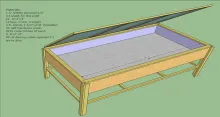
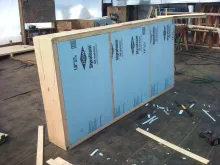
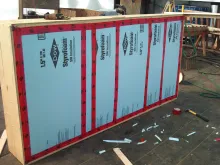
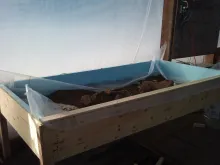
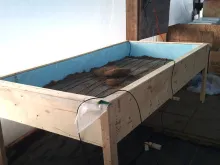
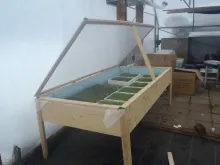
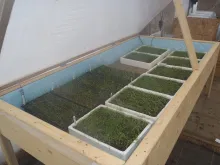
Comments
More detail, and possible options.
1. Detail on the controller for the deicing cable.
2. 9200 cubic inches of sand is somewhere between 5 and 6 cubic feet. Sand runs 150 lbs per cubic foot, increasing to 200 lbs /cuft if wet. This will require a heavier frame. I suspect taht this one, as diagrammed will sag and sink into the ground.
Suggestion: Use 3 2x4's on edge under the bottom. Secure every 8" with 2" deck screws -- ceramic coated (green or grey, not yellow)
For legs use doubled 2x4 and use 3 rows of 3. At attachment locations cut 16 x 16 right triangles of plywood to use as gusset joints.
3. The sand will get wet. Everything todo with gardening gets wet. Build your table with a 2" slant and have drain holes in one edge or corner.
4. Use coarse builders sand or even washed gravel if you don't want water to hang around inside.
5. The cable only needs to be held still while you put the gravel in. Duct tape or red tyvek sideing tape should work long enough for that, and has less chemical leaching.
6. You must use a weatherproof box for you connections. I would put the weatherproof box on a scrap of wood and put it under the germinator. If it's on a scrap, you can easily unfasten the scrap and bring it out to work on it. Being under the germinator will give in additional protection.
7. You must wire this through a ground fault interupter circuit. Otherside if a fault develops in that cable you could be pushing daiseys.
Further directions and ideas.
If the lid is easily removable, you can work from both sides.
If you are off grid, putting the entire device on an array of black plastic barrels then wrapping that array with clear plastic may generate enough heat. If you do this, don't insulate the bottom. If you end up doing a lot of starts this may have advantages even if you are on the grid.
You can achieve better temperature control if you separate the barrels from the germinator, (put the insulation back) and have a tiny pump to move warm water though tubes in the the sand.
I'm planning on installing